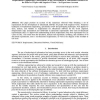Free Online Productivity Tools
i2Speak
i2Symbol
i2OCR
iTex2Img
iWeb2Print
iWeb2Shot
i2Type
iPdf2Split
iPdf2Merge
i2Bopomofo
i2Arabic
i2Style
i2Image
i2PDF
iLatex2Rtf
Sci2ools
CLEIEJ
2006
2006
Requirements Engineering Contributions on the Development of Educational Software for the Blind or People with Impaired Vision -
: This paper presents an account of the experience observed when obtaining a set of requirements for the development of educational software for people with impaired vision. Numerous techniques of requirements engineering, specifically review and prototyping techniques, were applied to elicit, analyze, and validate 51 requirements for educational software for the vision impaired. Requirements were documented and subdivided in functional requirements (FR) and non-functional requirements (NFR). To improve the understanding of these requirements, they were represented via Use Cases at UML. The results were the elicitation, analysis and negotiation, modeling, and validation of 40 functional requirements, and 11 non-functional requirements, as well as the diagram of the resultant of use cases.
| Added | 11 Dec 2010 |
| Updated | 11 Dec 2010 |
| Type | Journal |
| Year | 2006 |
| Where | CLEIEJ |
| Authors | Victor Francisco Araya Santander, Dorisvaldo Rodrigues da Silva |
Comments (0)

